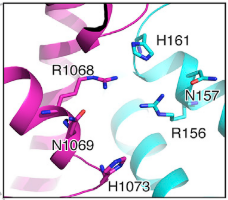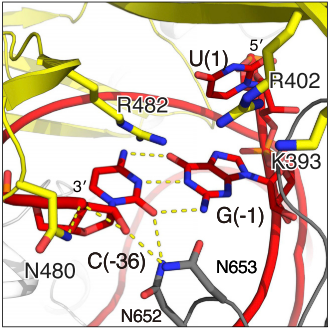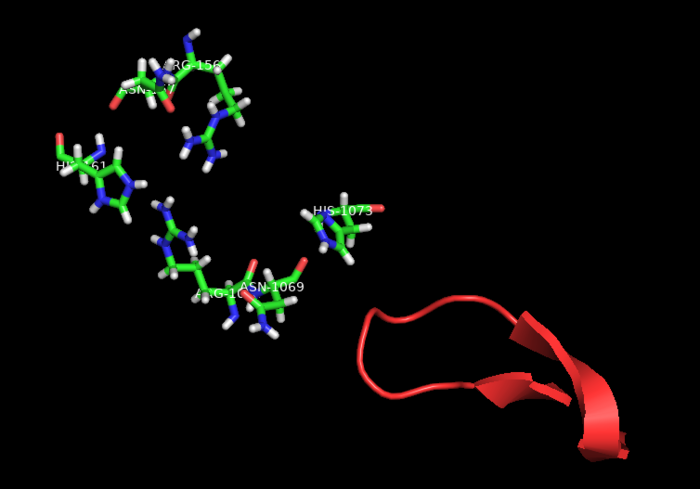User:Luis Andres Casavilca Ramirez/Sandbox 1
From Proteopedia
(Difference between revisions)
| Line 22: | Line 22: | ||
A highly conserved inter-domain linker (<scene name='81/817991/Idl/2'>IDL</scene>) connects HEPN1 with Helical-1 and spans a highly positivecentral <scene name='81/817991/Pbucas13b_central_channel/1'>inner channel</scene>, where crRNA lies isolated from the solvent. Helical-1 domain makes extensive contacts with the direct repeat of crRNA and minor interface contacts with both HEPNs and Lid domains, whereas Helical-2, which is composed of 11 helices, makes extensive contacts with HEPN1 and minor contacts with the extended beta-hairpin of the Lid domain. Between Helical1 and Helical2 domains there is a <scene name='81/817991/Channel_helicais/1'>side channel</scene> oppositely oriented from the Lid domain. This second side channel also is positively charged and establishes access to the unbound state crRNA from the solvent. | A highly conserved inter-domain linker (<scene name='81/817991/Idl/2'>IDL</scene>) connects HEPN1 with Helical-1 and spans a highly positivecentral <scene name='81/817991/Pbucas13b_central_channel/1'>inner channel</scene>, where crRNA lies isolated from the solvent. Helical-1 domain makes extensive contacts with the direct repeat of crRNA and minor interface contacts with both HEPNs and Lid domains, whereas Helical-2, which is composed of 11 helices, makes extensive contacts with HEPN1 and minor contacts with the extended beta-hairpin of the Lid domain. Between Helical1 and Helical2 domains there is a <scene name='81/817991/Channel_helicais/1'>side channel</scene> oppositely oriented from the Lid domain. This second side channel also is positively charged and establishes access to the unbound state crRNA from the solvent. | ||
| + | [[Image:Channel.png|550px|right|thumb| Fig.3 Positively charged central channel]] | ||
The Lid domain caps the 3’ end of the direct repeat with two charged <scene name='81/817991/Lid_beta_hairpin/1'>beta-hairpins</scene>(show3’ region and two beta-hairpins of Lid domain). This region has been demonstrated to function as a second nuclease site involved in pre-crRNA processing. Six conserved residues are predicted to coordinate and process crRNA at this second non-HEPN <scene name='81/817991/Lid_active_site/1'>catalytic site</scene>. (2)Unlike the HEPN active site, this nuclease site is thought to be metal-independent, since the activity of the equivalent crRNA processing site in Cas13a remains unaffected by the addiction of chelators and there is a formation of a 2′,3′-cyclic phosphate and a 5′-hydroxide on the 5′ and 3′ halves of the crRNA cleavage products, respectively. This last feature is characteristic of metal-independent RNA hydrolysis. (6,7) | The Lid domain caps the 3’ end of the direct repeat with two charged <scene name='81/817991/Lid_beta_hairpin/1'>beta-hairpins</scene>(show3’ region and two beta-hairpins of Lid domain). This region has been demonstrated to function as a second nuclease site involved in pre-crRNA processing. Six conserved residues are predicted to coordinate and process crRNA at this second non-HEPN <scene name='81/817991/Lid_active_site/1'>catalytic site</scene>. (2)Unlike the HEPN active site, this nuclease site is thought to be metal-independent, since the activity of the equivalent crRNA processing site in Cas13a remains unaffected by the addiction of chelators and there is a formation of a 2′,3′-cyclic phosphate and a 5′-hydroxide on the 5′ and 3′ halves of the crRNA cleavage products, respectively. This last feature is characteristic of metal-independent RNA hydrolysis. (6,7) | ||
| - | [[Image:Act2.png|550px|right|thumb| Fig. Second nuclease site]] | + | [[Image:Act2.png|550px|right|thumb| Fig.4 Second nuclease site]] |
| Line 37: | Line 38: | ||
The Cas13b-crRNA complex is practically inaccessible for hybridization with target RNA unless a major conformational shift allows access to the central channel. An opening between the domains HEPN1 and Helical-2 has been suggested, since it would provide a sterically permissible route with charged amino acids that would direct the RNA to the Cas13b central cavity. Mutation in a residue on a Lid domain β-hairpin (D397) at the interface between HEPN1 and Helical2 decreases Cas13 knockdown activity, suggesting an additional role of this domain in directing the target RNA into the central channel. | The Cas13b-crRNA complex is practically inaccessible for hybridization with target RNA unless a major conformational shift allows access to the central channel. An opening between the domains HEPN1 and Helical-2 has been suggested, since it would provide a sterically permissible route with charged amino acids that would direct the RNA to the Cas13b central cavity. Mutation in a residue on a Lid domain β-hairpin (D397) at the interface between HEPN1 and Helical2 decreases Cas13 knockdown activity, suggesting an additional role of this domain in directing the target RNA into the central channel. | ||
| - | [[Image:Selection_039.png|550px|right|thumb| Fig. | + | [[Image:Selection_039.png|550px|right|thumb| Fig.5 Proposed mechanism of crRNA targeting by Cas13b]] |
The 3’end of target RNA is less tightly bound within the central channel and more tolerant of mismatches that the 5’end, thus being proposed as being initially recognized by the complex. In this suggested model the protein-crRNA complex initially probes the 3’RNA end of target RNA, allowing the opening of HEPN1 and Helical-2 domains and access to the central channel after complementarity is found. Then, the rest of the target RNA is hybridized. (Fig.2) | The 3’end of target RNA is less tightly bound within the central channel and more tolerant of mismatches that the 5’end, thus being proposed as being initially recognized by the complex. In this suggested model the protein-crRNA complex initially probes the 3’RNA end of target RNA, allowing the opening of HEPN1 and Helical-2 domains and access to the central channel after complementarity is found. Then, the rest of the target RNA is hybridized. (Fig.2) | ||
| Line 47: | Line 48: | ||
== Cas13b engineering == | == Cas13b engineering == | ||
| - | [[Image:ActLoop.png|700px|left|thumb| Fig. | + | [[Image:ActLoop.png|700px|left|thumb| Fig.6 HEPN2 conserved loop at active site]] |
The aforementioned preference for target RNA cleavage at dinucleotide sites is somewhat conserved among Cas 13 enzymes. A beta-hairpin loop located near the active site at HEPN2 domain is conserved among Cas13 from different species. Though the identities of its residues are variable, it is always located between highly conserved amino-acids (2) In PbuCas13b, mutants with altered residues at this loop that retained cleavage activity showed different cleavage preferences, and some of them even had increased preference for UU dinucleotides. SHERLOCK (Specific High-Sensitivity Enzymatic Reporter unLOCKing), an mRNA detection technique that takes advantage of the promiscuous cleavage activity of Cas13s is limited by the nucleobases identities of some of transcripts.(8) Therefore, Cas13b engineering at this conserved loop could potentially increase the repertoire of substrates for these type of techniques. | The aforementioned preference for target RNA cleavage at dinucleotide sites is somewhat conserved among Cas 13 enzymes. A beta-hairpin loop located near the active site at HEPN2 domain is conserved among Cas13 from different species. Though the identities of its residues are variable, it is always located between highly conserved amino-acids (2) In PbuCas13b, mutants with altered residues at this loop that retained cleavage activity showed different cleavage preferences, and some of them even had increased preference for UU dinucleotides. SHERLOCK (Specific High-Sensitivity Enzymatic Reporter unLOCKing), an mRNA detection technique that takes advantage of the promiscuous cleavage activity of Cas13s is limited by the nucleobases identities of some of transcripts.(8) Therefore, Cas13b engineering at this conserved loop could potentially increase the repertoire of substrates for these type of techniques. | ||
Revision as of 13:13, 17 June 2019
==Cas13b==
| |||||||||||
References





